MiGs, Stars & Magic Books: A Brief History of Trespassing in Moscow
An illustrated guide to urban exploration in the Russian capital.
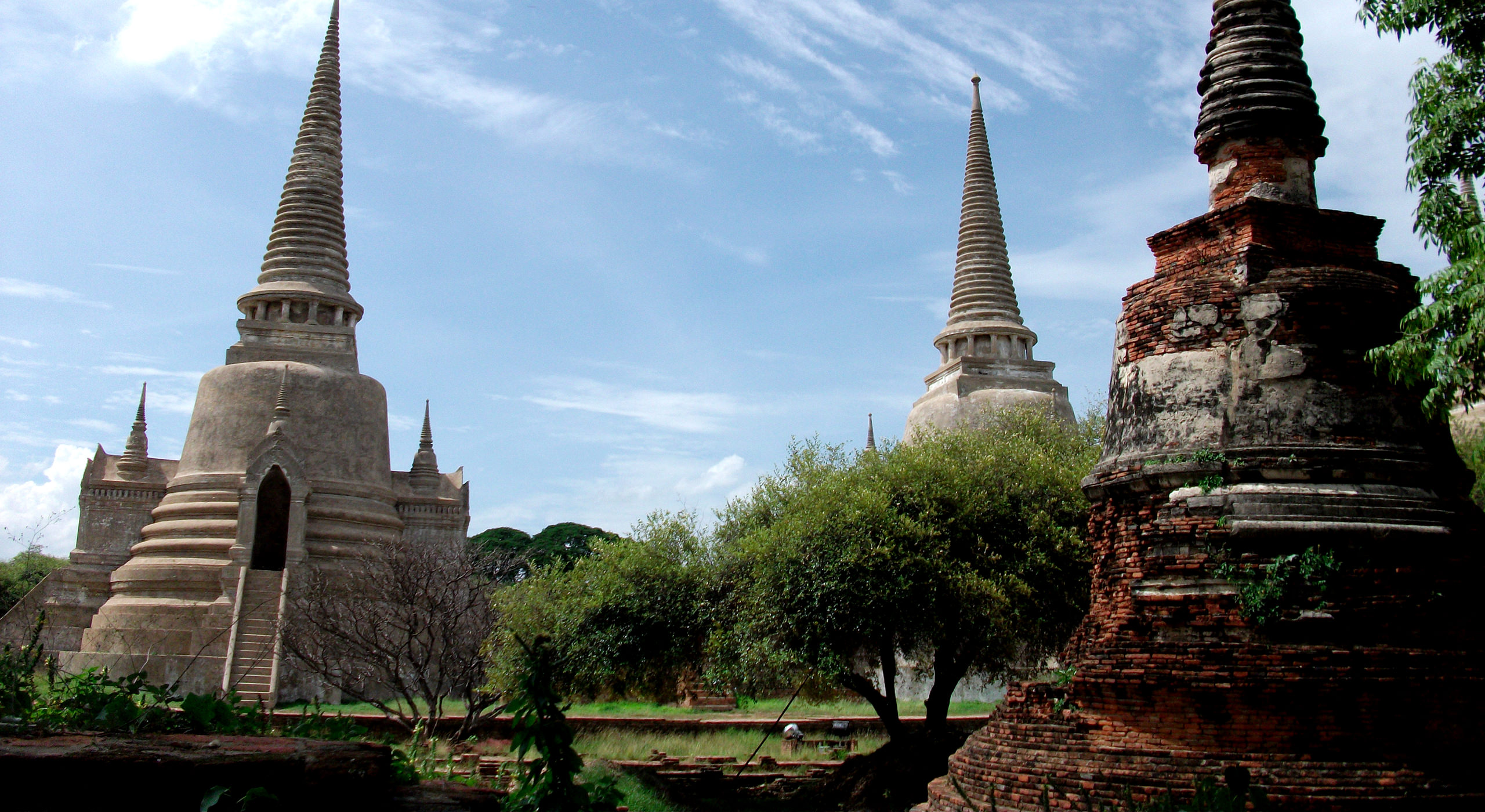
25 January 2013
Located 80km north of Bangkok, the ancient Siamese capital of Ayutthaya sits on an island at the confluence of the Lopburi River, the Chao Phraya River and the Pa Sak River. Nowadays it’s little more than a sleepy market town, while Ayutthaya’s many ruined temples and palaces are some of the most enduring icons of Thai Buddhism.
However, a darker current lies beneath the surface of this picture-postcard destination. In 1767 the Burmese invaded Siam, leading to the ruthless sacking of Ayutthaya. The ensuing massacre reduced many of the city’s temples to rubble, and a tour of these breathtaking monuments reveals a hidden history of cruelty and persecution.
The Kingdom of Ayutthaya existed from 1350 to 1767, located in the heart of Thailand… or as it was known at the time, ‘Siam’. This was the precursor to the current monarchy of Thailand, and after four centuries of rule it was finally brought to a violent end during the Burmese–Siamese War of 1765–67.
As the Burmese swept east across Siam, the capital of Ayutthaya came under siege for the second time in 200 years. Whereas the Kingdom of Ayutthaya survived the 16th century Burmese invasion however, this time the city fell – and at sunset on April 7th 1767, the Burmese finally made it over the city walls. In the chaotic massacre which followed, starving inhabitants of the city were slaughtered on site, while every building was set alight.
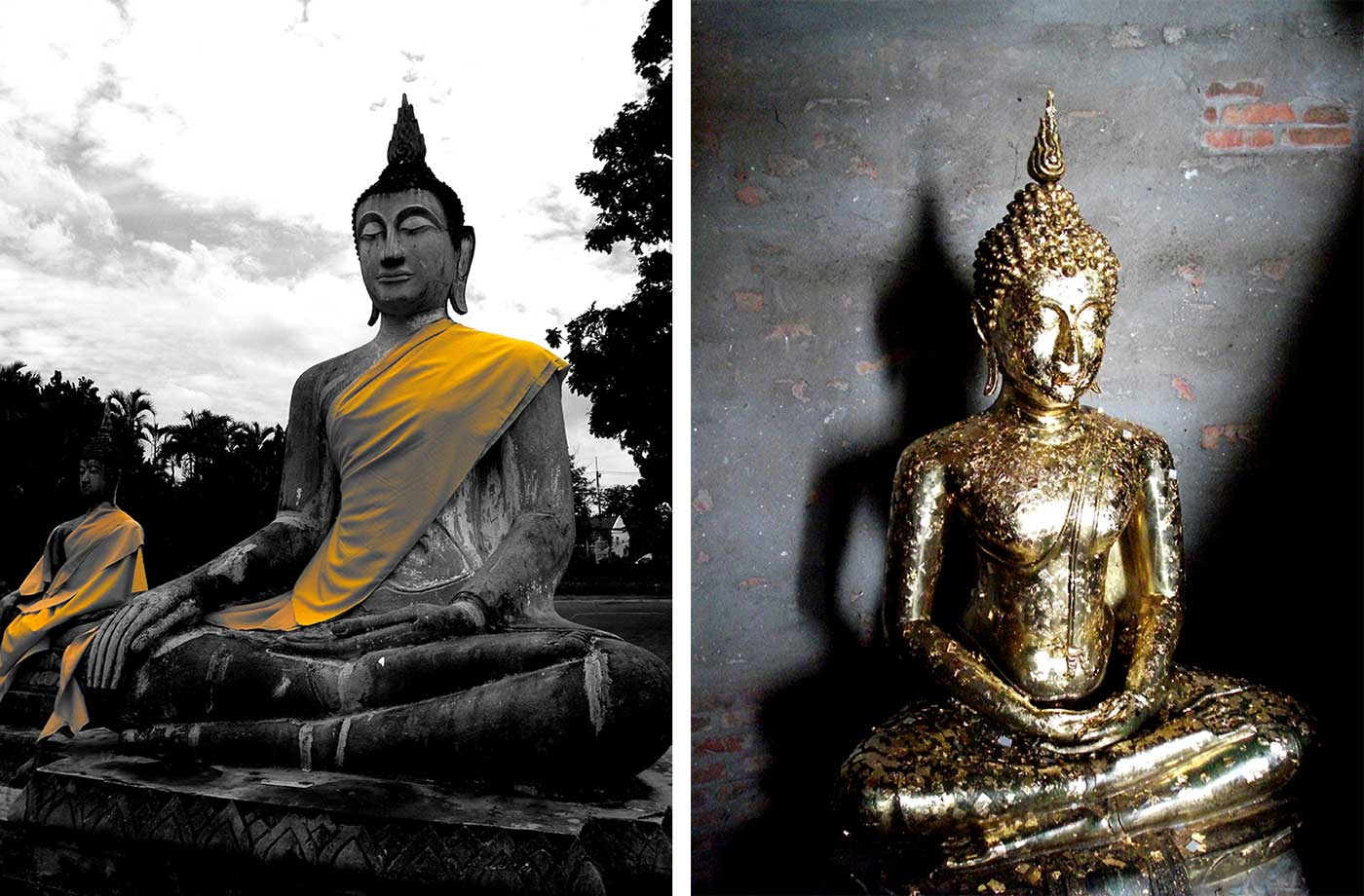
I visited this ancient city with a couple of travel buddies I had picked up in Bangkok. While a day tour of Ayutthaya costs somewhere in the region of 1,000 Baht (about £20) from most Bangkok travel agents, we opted instead for a local train service – paying the equivalent of just a few pounds for the two-hour journey.
The temples (or ‘wats’) of Ayutthaya range from bustling centres for prayer and worship, through to sacred, rocky ruins. With a huge number of holy sites scattered around the town and surrounding area, exploring them on foot would make for a monumentous task.
We caught a pedestrian ferry from just opposite the train station, crossing the river towards the historic heart of Ayutthaya. Here we stumbled across a bustling market full of spices, meat and fine fabrics. Flies buzzed noisily around a stack of severed pig heads on nearby stall, while solitary rats stalked the blood-stained gutters.
Outside the market we caught the eye of a waiting tuk-tuk driver. After some negotiations, we agreed on a rate of 750 Baht for a day’s tour; at 250 Baht each – about a fiver – we probably should have angled for less.
Our driver would prove an invaluable asset however, and spent an entire day driving us around the town of Ayutthaya while sharing his wealth of local knowledge.
Our first stop was at Wat Yai Chai Mongkol; or as it is sometimes known, ‘Wat Yai Chai Mongkhon’. Located southeast of Ayutthaya across the Pridithamrong Bridge, this living wat is a popular destination for both tourists and worshippers alike.
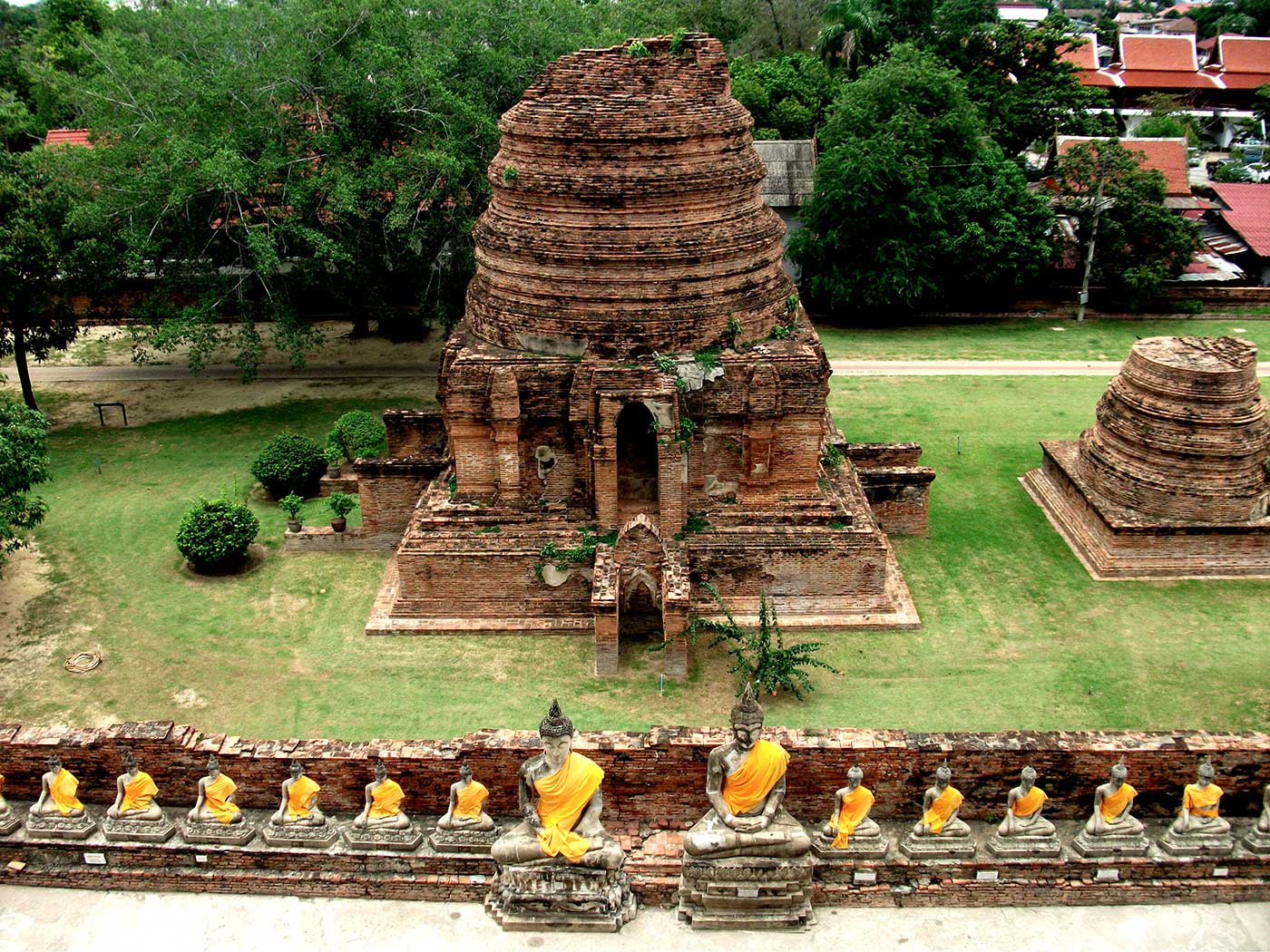
The wat is centred around one vast stupa (or ‘chedi’), which towers over the skyline for miles around.
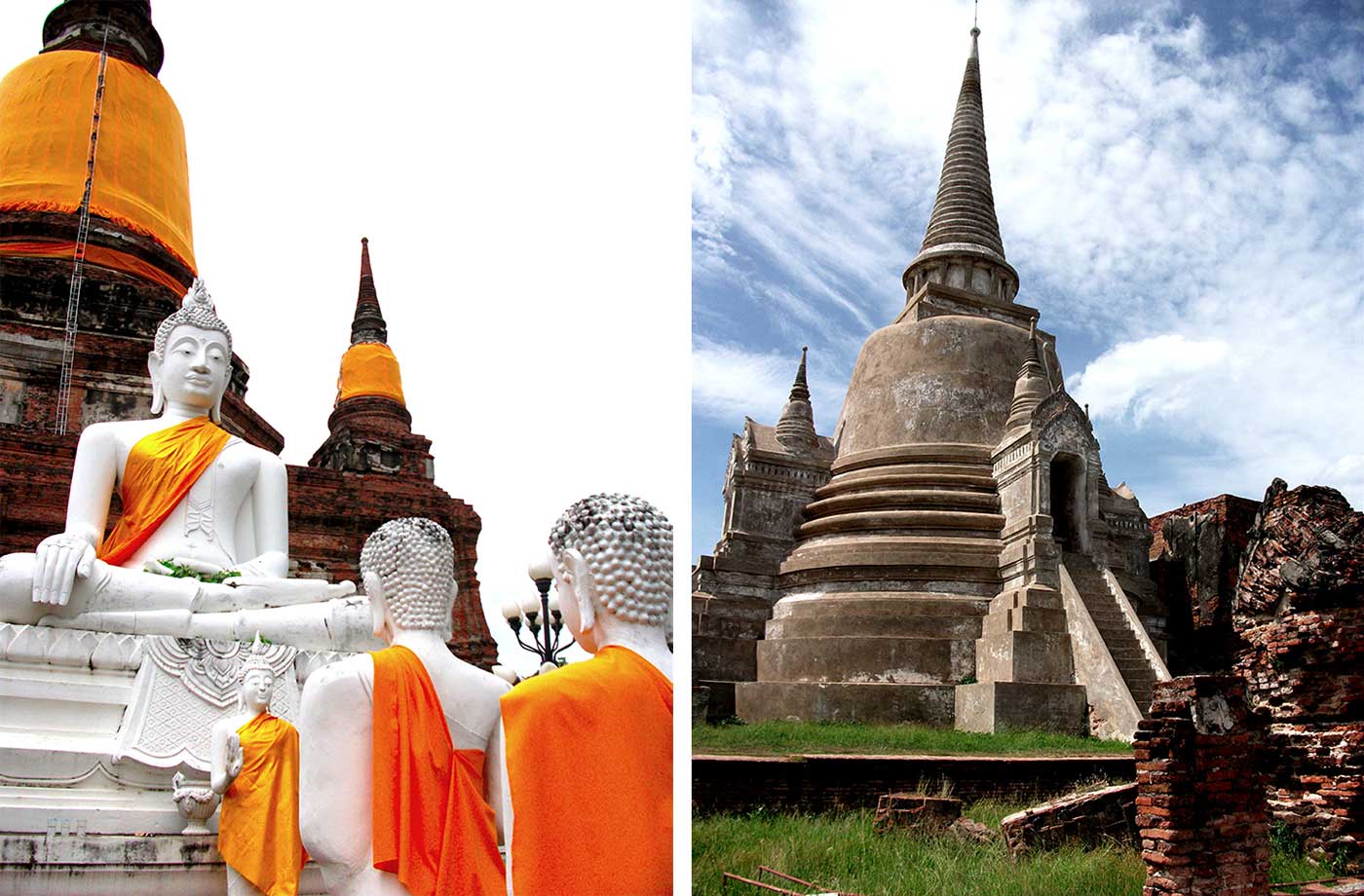
Arranged around the stupa lay ornate, green gardens, populated by tropical birds and white stone buddhas. Some of these likenesses stood in line to receive a blessing, others sat in solitary mediation. Around the central stupa the buddhas fanned out in long rows of near identical figures; though closer inspection revealed subtle variations in posture and facial expression.
Wat Yai Chai Mongkol was built in the year 1357, by the first ruler of the Kingdom of Ayutthaya – King Uthong. The site was dedicated to the monks of the Pa Kaeo Sect, recently returned from Ceylon where they had been studying under the influential Buhddist teacher Phra Vanarat Maha Thera. The monastery which was born here took its name from them: ‘Wat Pa Kaeo’.
In time the head of the sect was raised by King Uthong to the position of ‘Patriarch on the Right Hand Side’… and so the monastery soon became ‘The Temple of the Supreme Patriarch’, or ‘Wat Phra Chao Phya-thai’.
When the first Burmese invasion force arrived at Ayutthaya in 1592, reigning monarch King Naresuan the Great fought valiantly to defend the city; according to the story, the king rode out on elephant back to meet the Burmese leader in single combat. The chedi at Wat Phra Chao Phya-thai was raised in memory of his victory.
Although the grand chedi at Wat Yai Chai Mongkol is held sacred by the monks who still live and worship here, visitors are permitted to enter during the day.
The steep ascent up stone steps cut into the side of the stupa was made all the more challenging by the sweltering Thai sun – but was rewarded with a cool, serene prayer chamber set inside the spire, its walls lined with golden figures of the Buddha in smiling contemplation.
Not far from Wat Yai Chai Mongkol, we came across another active temple; this time at Wat Phra Chao Phanan Choeng.

Unlike the monastery of Wat Phra Chao Phya-thai, the temple here – sometimes simply referred to as ‘Wat Phanan Choeng’ – appeared to serve Buddhists from all walks of life.
Sat right on the bank of the Chao Phraya River, this wat was allegedly built in the year 1324 – 26 years before the founding of Ayutthaya itself. Later, in 1407, the temple was mentioned by the Chinese Muslim historian, Zheng He.
As we headed inside the main buiding, even our tuk-tuk driver stopped to pay homage to a flower-strewn figure of Ganesha [1]. The main focal point of Wat Phanan Choeng however, is one of the largest Buddha figures to be found anywhere in Thailand.
Reaching a height of 19 metres, the reclining titan known as ‘Luang Pho Tho’ is housed within a specially constructed building. As we approached the Buddha’s chamber, we found it full of Thai children. The Buddha’s orange sash seemed to fray into a dozen separate strands of silk. The children sat crowded around the Buddha’s feet, wrapping themselves up in the long strips of sacred cloth, or hiding beneath it as a part of some ceremony.
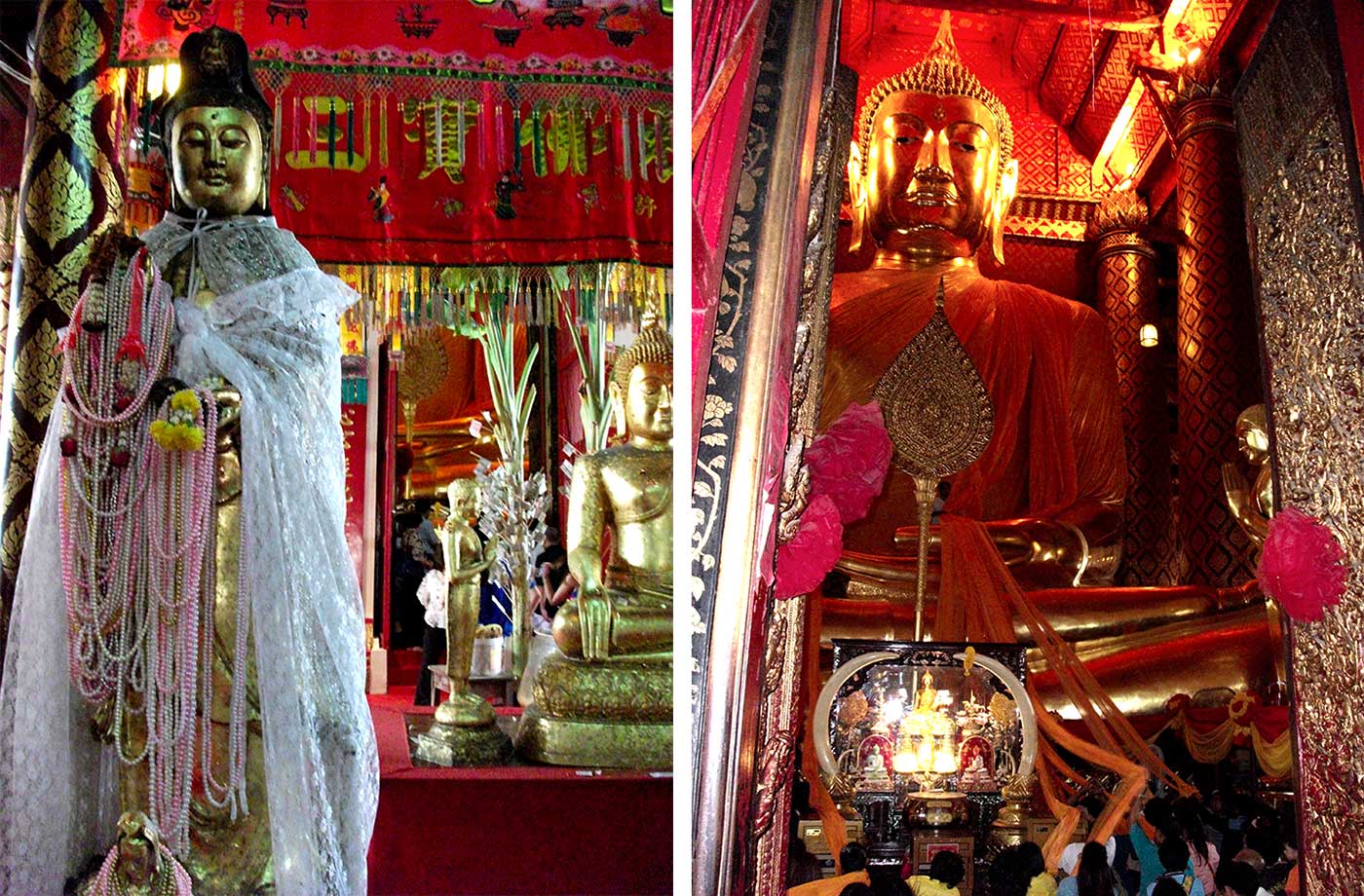
Our next stop would take us to the former site of the Royal Palace, and the most magnificent of Ayutthaya’s ghost temples.
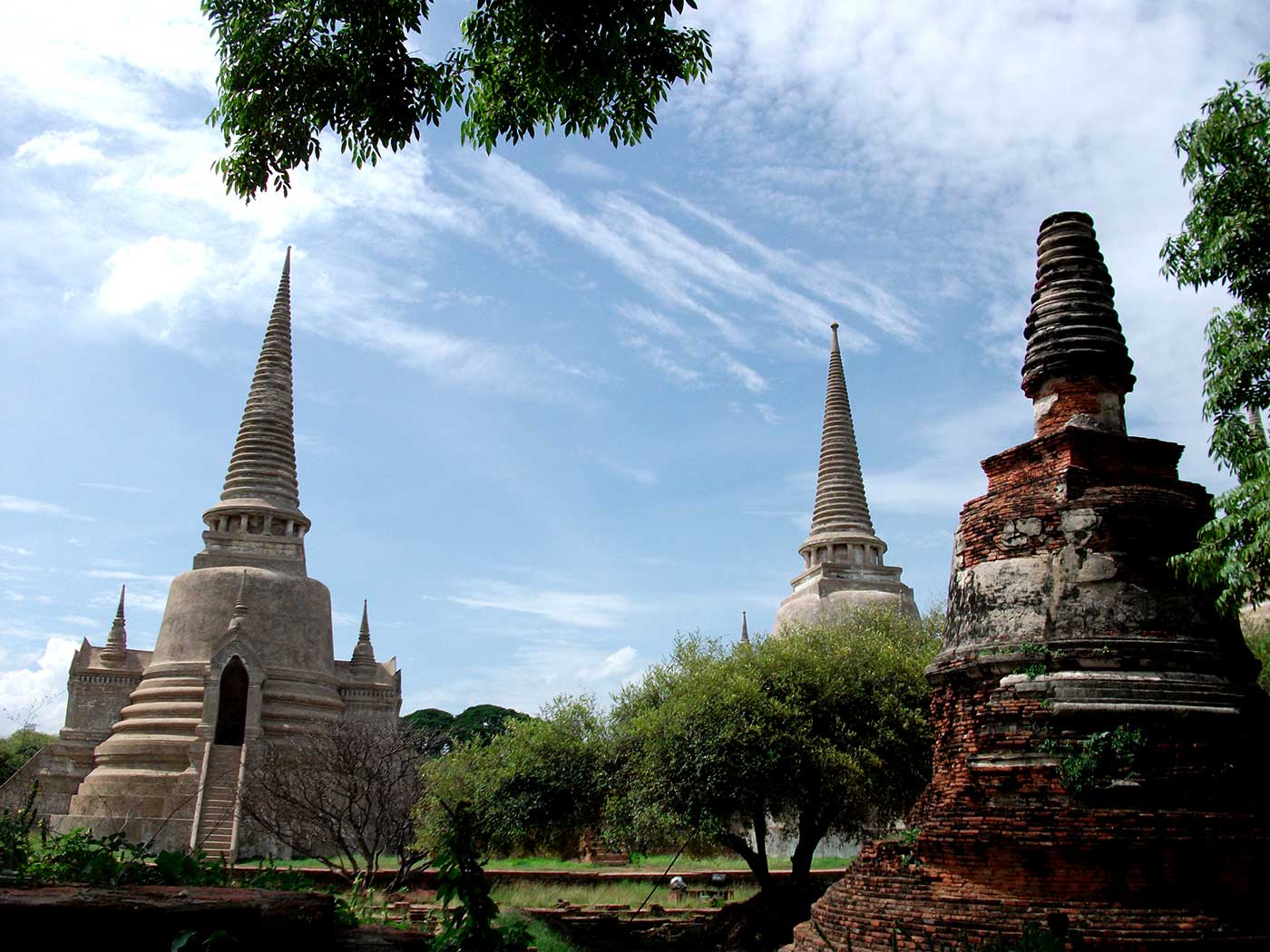

Wat Phra Si Sanphet is now surrounded by the Ayutthaya Historical Park.
Here visitors can take a ride on an elephant, or watch a monkey show; there are shops and restaurants located in one large covered market, while the picturesque streams that criss-cross the park are populated by prehistoric-looking monitor lizards – which can grow to as much as two metres in length.
The construction of Wat Phra Si Sanphet took place during Ayutthaya’s ‘middle period’, at the behest of 15th century King Trailok. This wat is distinguished by a series of three immense, grey stone chedis. These were joined in 1499 with a Viharn built by King Rama Thibodi II, designed to contain a vast Buddha plated with roughly 200 kilos of solid gold. This figure was named ‘Phra Si Sanphet’, from which the title Wat Phra Si Sanphet is derived.
The chedis stand to this day; the Viharn was destroyed by the Burmese however, and its precious custodian stolen away [2].
Visitors at Wat Phra Si Sanphet are given free range to explore the ruins, presided over by the three grand chedis. Broken colonnades tail off into the dust, while here and there amongst the foliage you’ll find half-formed courtyards and mutilated figures of the Buddha. The site is curated by local monks, and even the headless effigies are lovingly adorned in orange silk sashes.
This wat is a popular destination for both foreign tourism and Buddhist pilgrimages… as was apparent from the group of robed monks, who stood posing for photos in front of the ruins. The three chedis themselves are believed to contain the relics and ashes of Ayutthaya’s greatest rulers: King Trailok, King Borom Ratchathirat III and King Rama Thibodi II.
A series of steps leads up to each of these stupas. The entrance to the first was sealed with bricks, while the second opened into a simple stone chamber. Here, peering into the gloom, I found a large bat nestled into the apex of a brickwork arch.
When I came to look at the third stupa I discovered a shallow passage, bricked in on all sides. A plastic-wrapped package left on the earthen floor contained the freshly laundered orange robes of a Buddhist monk.
At the back of this chamber, part of the brickwork had weathered away to leave a narrow gap though the wall into the tomb’s darkened interior. My curiosity was aroused, and so I squeezed myself through the rough hole; falling face-first into the narrow space beyond. Here a small passage veered first to the right, before correcting its aim towards the centre of the chedi. I wriggled through the tiny space on my elbows and knees… at times wondering what I was doing, but more often wondering what I would find.
I would know soon enough.

The passage opened up suddenly around me, into a high, hollow chamber right at the chedi’s core. It was pitch dark inside, though there was a freshness to the air. And, as I listened, I became aware of a noise.
The sound was hard to place; a faint crackle and hum that seemed to come at me from all directions. Then I recognised the distinctive, throaty chirruping of bats. I reached for my phone’s LED torch, and my heart skipped a beat as I found myself surrounded by a frantic whirlwind of leather wings.

Still high on adrenaline from my experience in the batcave, we made it to the last stop on our Ayutthaya tour: the 14th century Wat Phra Mahathat.
Wat Phra Mahathat is characterised by its rich, red brickwork set through with traces of black and brown. The central structure resembles the cubist form of a Mayan pyramid, although little now remains of this once-glorious place of worship; of all the temples of Ayutthaya, this site was amongst the worst casualties of the Burmese invasion.
By the time we arrived, storm clouds were gathering… just five minutes later the skies opened up and the monsoon hit us.
I discovered during this trip that I’m actually a huge fan of Thailand’s monsoons. The rain usually falls for between 10 minutes to an hour each day, and it comes down warm and hard. It’s a feeling not dissimilar to a modern power-shower. Almost invariably the storm is followed by bright, hot sunshine, drying clothes in a matter of minutes.
And so we explored Wat Phra Mahathat at our leisure – oblivious to the raging storm, and the other visitors who were busy sprinting for the cover of trees.

Perhaps the most striking feature of Wat Phra Mahathat is the abundance of broken Buddhas on display. The Burmese were thorough in their destructive efforts, and the many sacred figures were smashed into countless smaller pieces. In the aftermath of the invasion the monks attempted to repair the damage – hunting through piles of broken faces, severed hands and dismembered stone torsos for parts that matched.
The results leave much to be desired; but Wat Phra Mahathat’s row upon row of Frankenstein Buddhas nevertheless speak volumes about the dedication and perseverance of these monks. It’s hard not to find oneself in awe of such labours… but at the same time, these mutilated bodies present an all-too-vivid metaphor for the true horrors of the massacre that befell here.
One last, lingering image is to be found in a shaded corner of the temple grounds. Here the decapitated stone head of a Buddha has fallen amongst the roots of a tree – and over the course of several hundred years, has become absorbed into the wooden tangle.
Now the Buddha peers out from the tree itself, watching with a knowing smile as nature begins to reclaim the ghosts of ancient Siam.

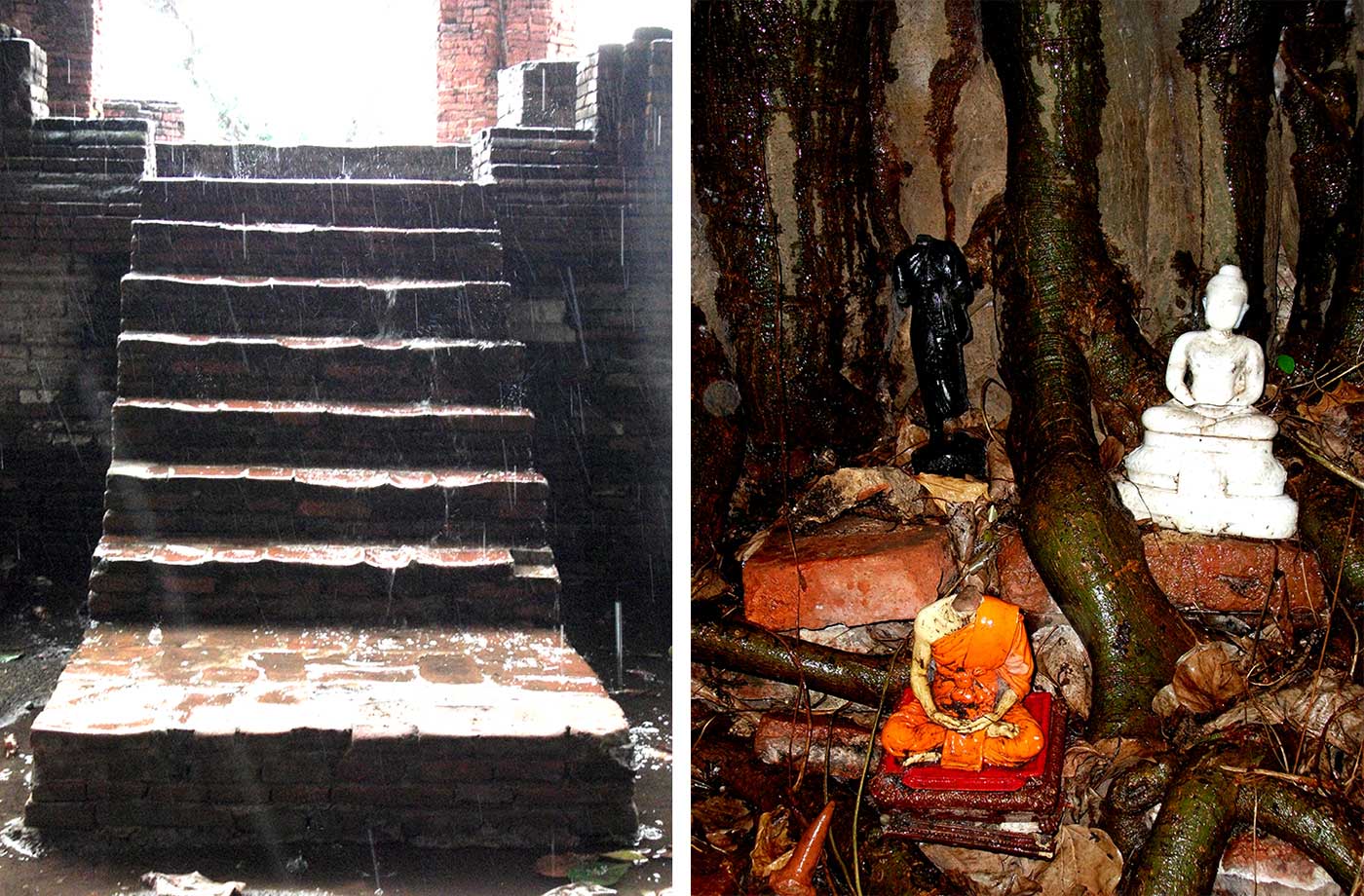


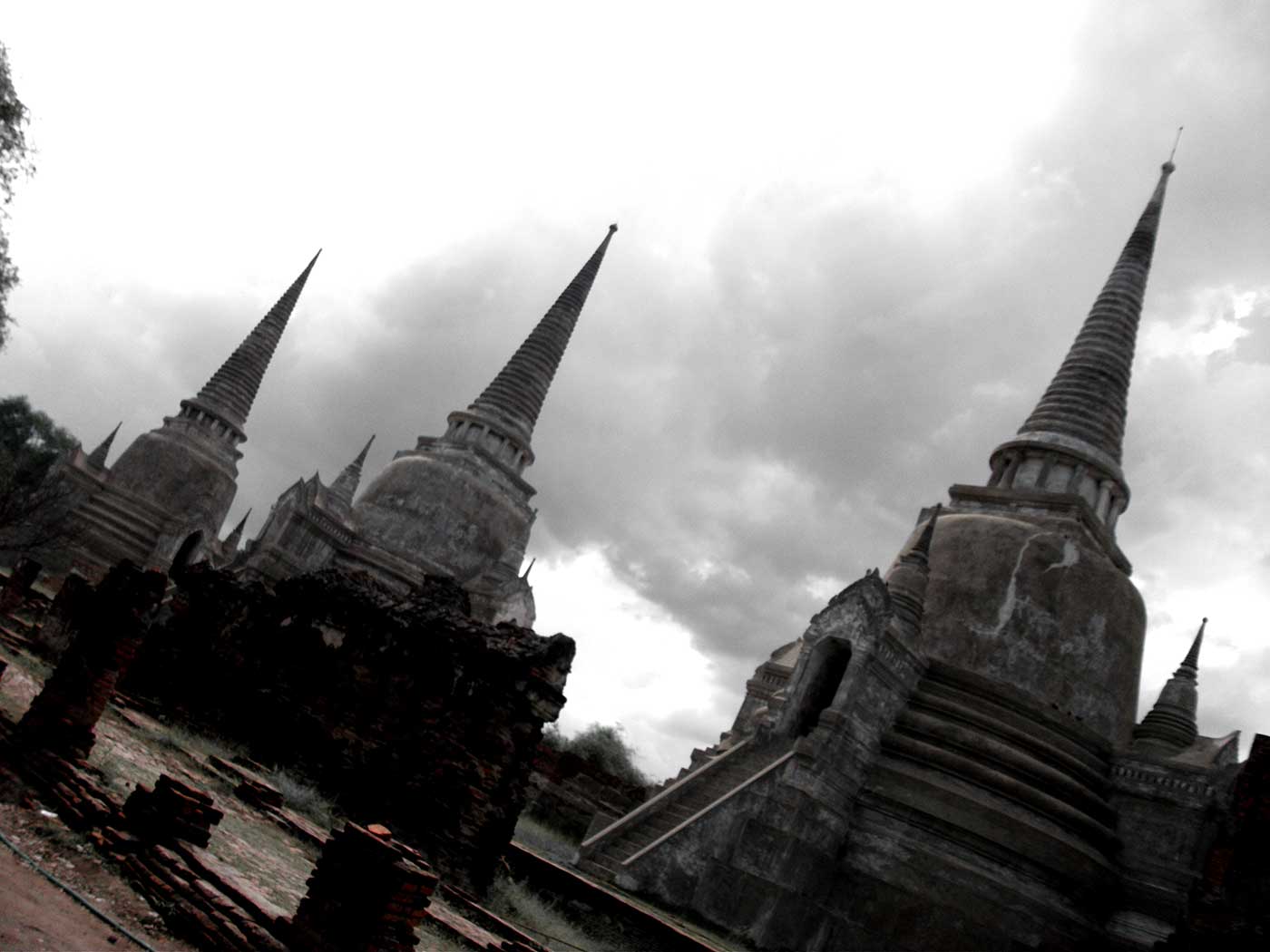
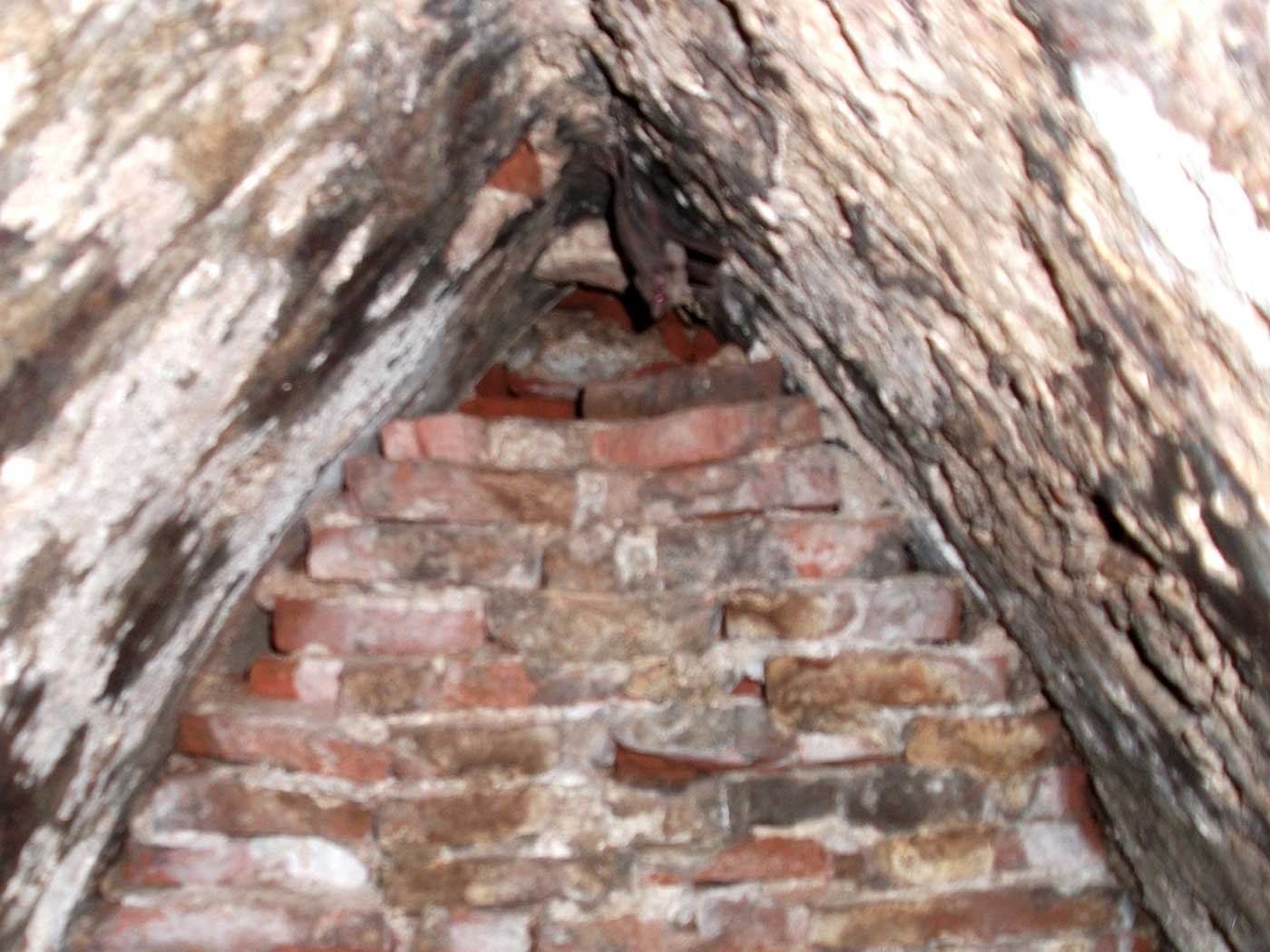


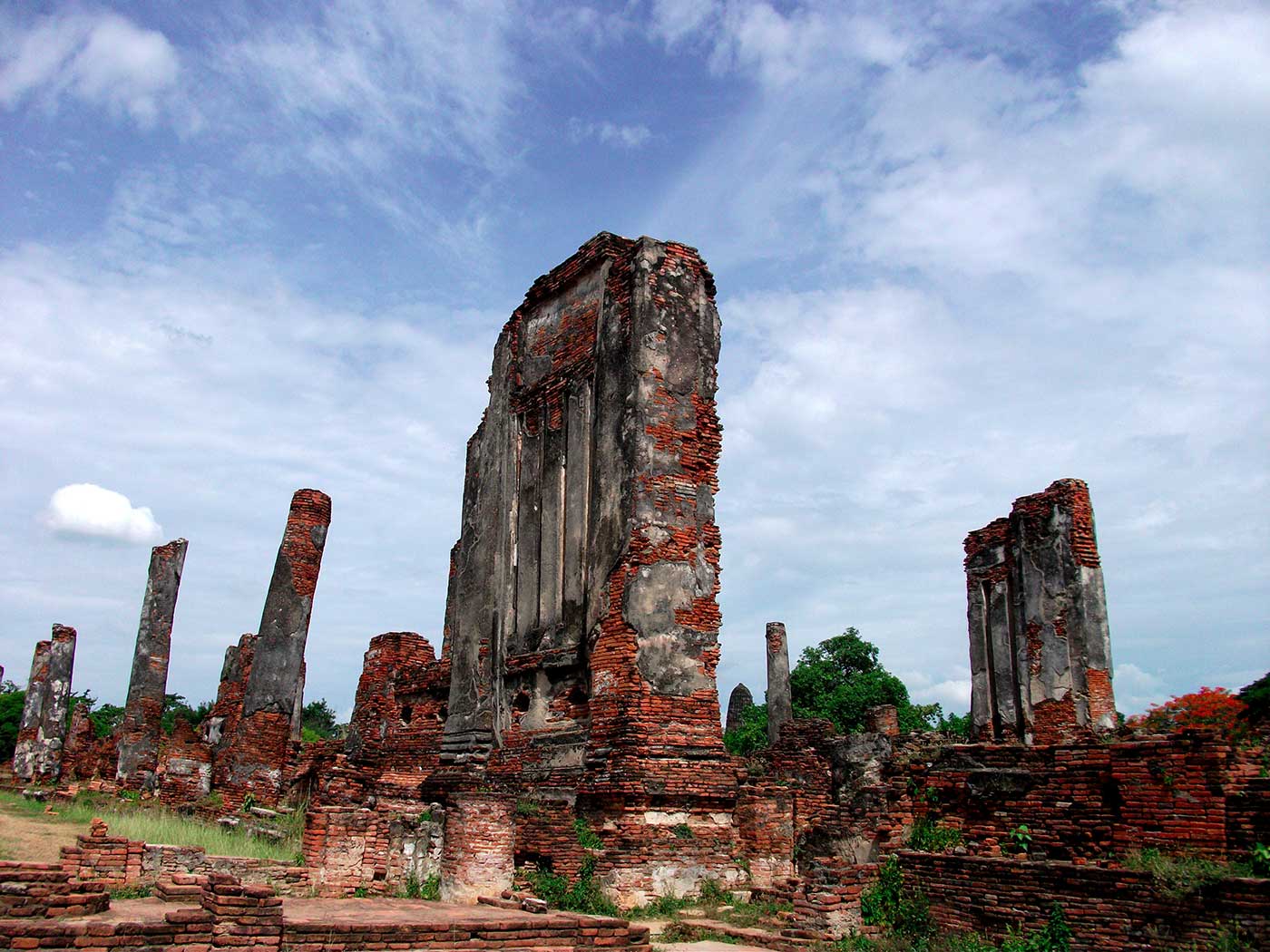

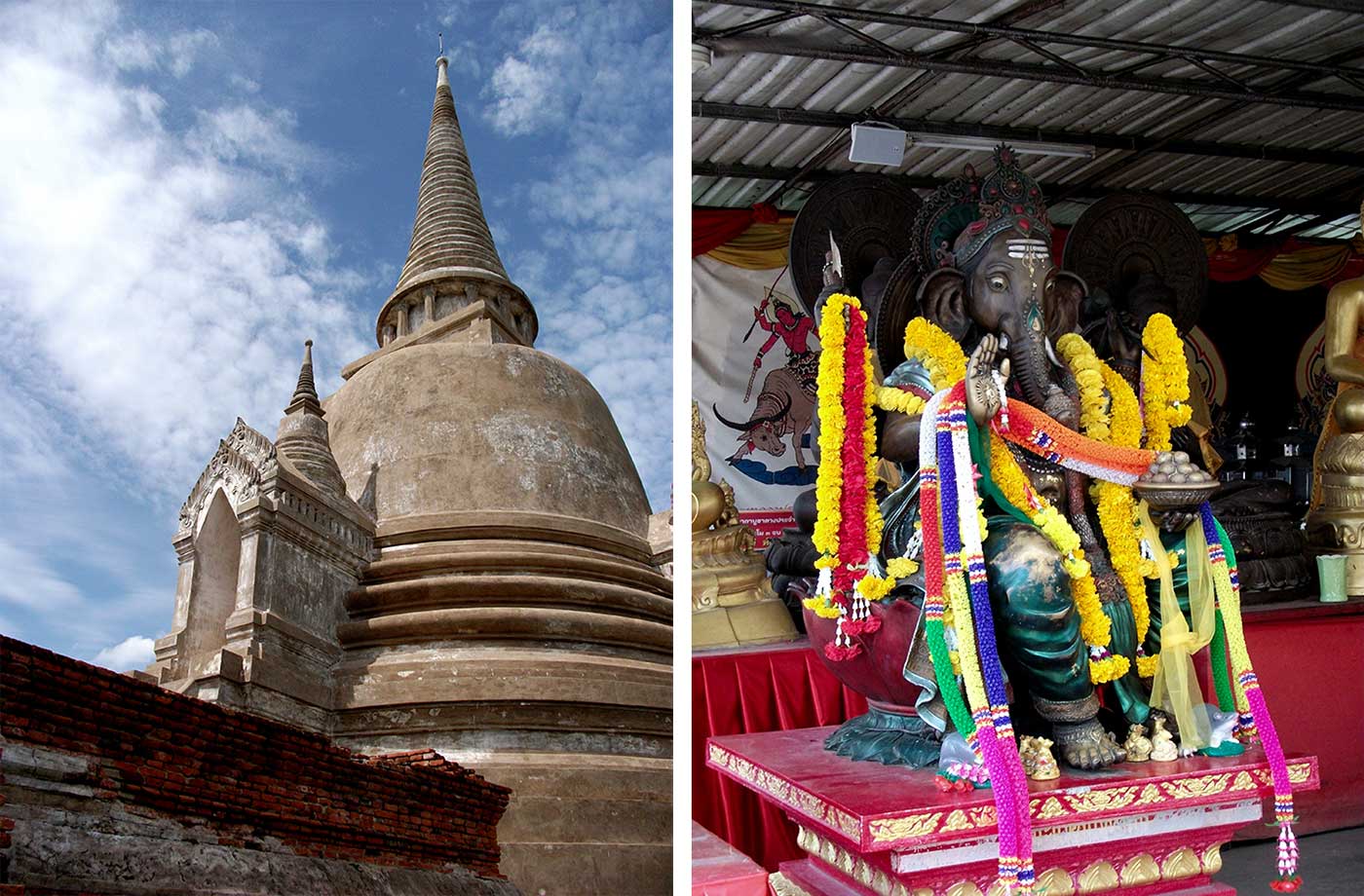
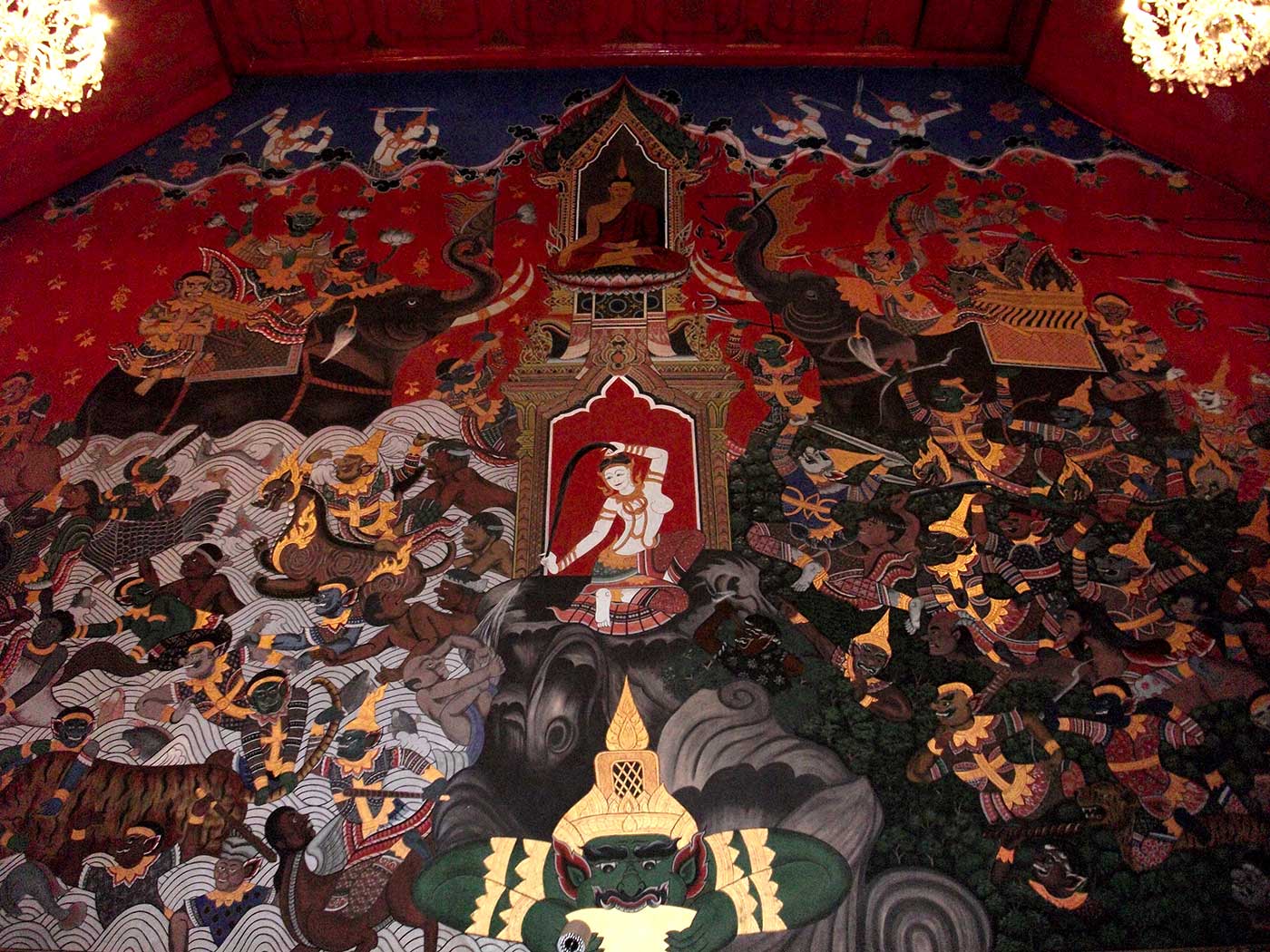
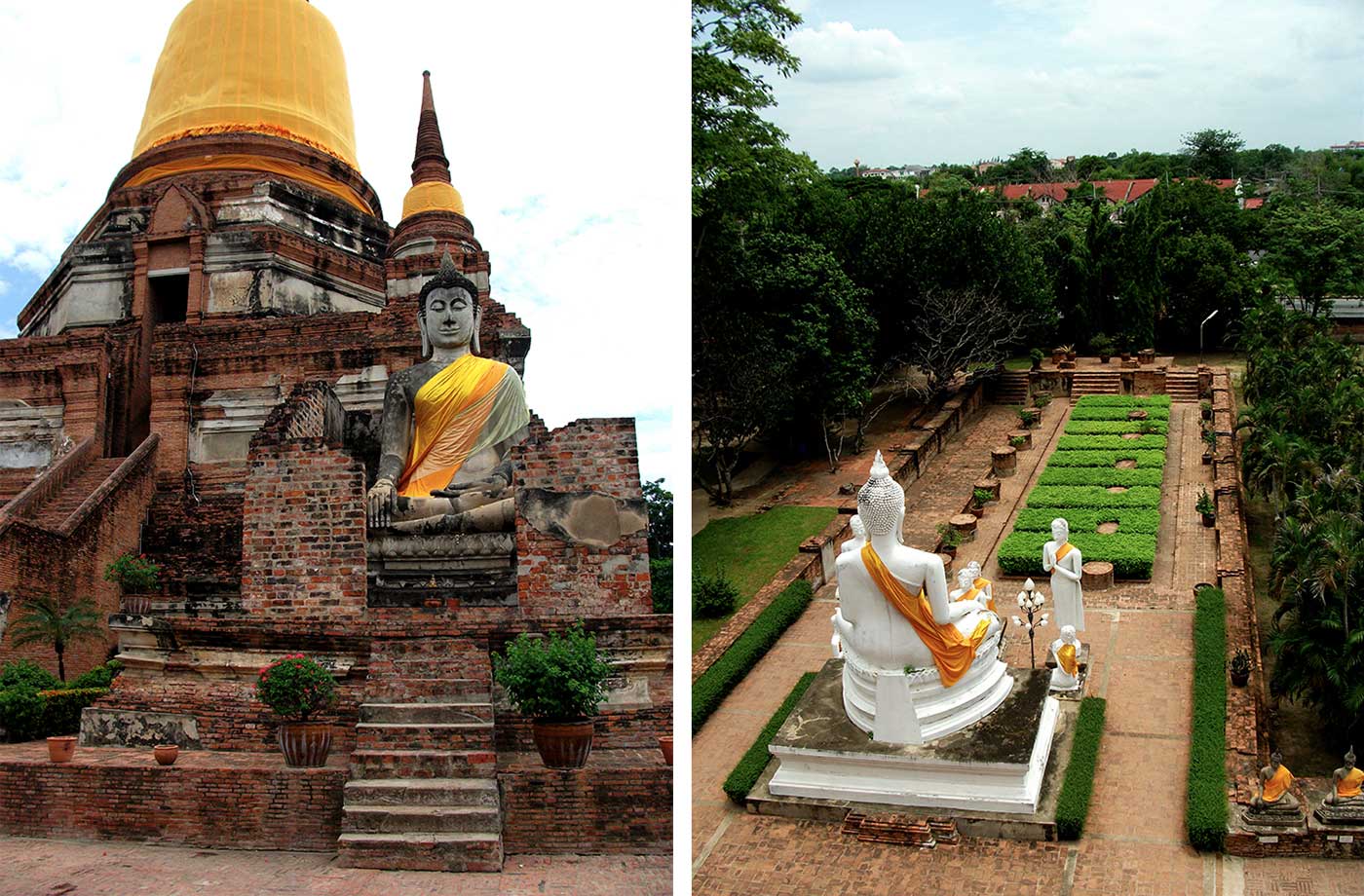


[1] While Ganesha is a figure traditionally associated with the Hindu pantheon, many such gods have been adopted into the practice of Thai Buddhism over the years.
[2] In the years since the Burmese invasion, some parts of the golden Buddha image have been restored; they are now on display at Bangkok’s Wat Pho.



Comments are closed.
See all 23 comments on “The Fall of Siam & the Lost Temples of Ayutthaya”

An illustrated guide to urban exploration in the Russian capital.

Poltergeists, ritual murder & a live-in succubus – the 1000-year-old pub with a ghostly reputation

A month-long monument hunt, and what I learned along the way.
I don’t get Thailand, formerly known as Siam. Their language is said to be borrowed from the Khmr people of Cambodia… yet Cambodia is a second class Hell hole to Thailand. Also Laos speaks a similar language which means the people’s in the region must have common ancestors yet Thailand is more developed and the currency is worth more. SECOND… if the Burmese invaded twice… then why does every puritanical pandering parrot say that Siam was never occupied or colonized.. unlike Malaysia, Philippines and Indonesia, etc.?? Sounds like they got their asses kicked. Why didn’t Burma remain and take control over Siam? THIRD… Thais have statues of the original founder of Indian Buddhism, the Indian Buddha, from 6 century B.C. ALL OVER THE PLACE and borrow Indian Hindu mythology as their “National Epic”. It makes them look Hindu. Also the blood sacrifices, now replaced by Strawberry Fanta… haha… is KALI-MA, the dark Indian religion that is said to have affected even the Mayans… it spread worldwide but people don’t realize this.
you really have a point , and since I’m from Thailand and I don’t really agree with how Thais say we are never occupied , AT ALL. So I might explain it , neutrally. First of all , the language of Thais , it is true that we borrowed it from Khmer , in fact , we also borrowed some from Myanmar and India too . We don’t really have our own word , except like , colour , some flower name , normal adjective and spoken word . Even the word walk in Thai are borrowed from Khmer xD, it is maybe because we used to be one with Khmer ancient , and the part that you say we have similar language with Laos , I must really say that we somehow share our ethnic . But I have to tell you that the only similar spoken language we have is between Laos and Thailand ‘ s northeast. But for the formal language, it maybe almost as same as every country in the SEA, I mean Khmer, Laos, Thailand and Myanmar. So yup ,and I really like the fact you ask that how come the Thais say so proud that they were never occupied, that’s very funny even I am Thai . If I have to say it from my point of view, I will say that Thailand has twice occupied, probably three time too, since we used to lost a few of our region to France. And the reason Burma didn’t remain take control over us, I don’t really have enough information, but I think it’s because of when we were under Burma’s control, it’s almost the same time as England invaded Burma, so they need to withdraw and went to fight England. I guess that’s the reason. And last but not least, Thais really mixed Hindi and Buddhism together, I don’t really know why too. Sorry that I can’t answer the last one,
I hope this may help you, at least a little bit. If you have anything about Thai you can just ask me tho! But I maybe answer very slow since I am still in my high school lol.
P.s. , Buddhism was first brought in Thailand by ancient Khmer.
It was all originally part of the Ancient Khmer Empire. Cambodia was a peaceful agrarian haven until the American war against Vietnam spilled over its borders and everything was destroyed.
ada kemungkinan kerajaan siam diceroboh dari dalam. kerajaan terdahulu yang ditubuhkan oleh 3 sahabat mungkin berebut untuk menguasai ayutthaya. saya dapati siam bukan thai. apabila kerajaan siam diceroboh ia diganti oleh burma dan thai. kemudian thai yang tidak mengaku pernah dijajah kerana mereka merasakan negara itu juga diasaskan bersama-sama nenek-moyang mereka.
I went to Ayutthaya in June this year. We hired a tuk tuk for 4 hours and covered 6 Wat’s, next time will have to stay overnight as there was lot’s more to see. I wish I had a better camera when I went as your photos are fantastic. I’ve added a link to your post on my blog. http://thetravellingphase.com/wat-phra-sri-sanphet-ayutthaya/
Thanks for sharing the link, Graham! Six temples in a day is pretty good going – but as you say, there are so many of them that an overnight stay is probably a better way to approach Ayutthaya. Guess I’ll have to return there someday… nice blog, by the way.
I don’t count anymore how many times I’ve been there, it’s just so easy from Bangkok and full of good spot for photography ! Seems that you a had a pretty good time there ! You can see examples on my blog http://www.la-thailande-et-l-asie.com/photos-thailande/centre/ayutthaya/
The only thing I’ve never done yet, is a river cruise in the area… hum, guess i’ll have to come back as well.
You have some fantastic photos here, Romain! Thanks for sharing that link. A river cruise sounds like an amazing way to explore the area, too.
Thanks for the great info about the interiors of the three stupas. When I was there I only climbed to the one bricked off in the assumption that the other two were the same. A truly amazing site, visitors are very lucky to get so close. I really appreciate your curiosity and nerve.
Hi Sophie.
That’s the one I saw first, too. However I am nothing if not stubborn, and when I came to try the other two I found them a good deal more accessible.
Anyway thanks for the kind words, and I’m glad you appreciated the report.
GOood to remind people of the story of the end of Ayutthaya. Most people come here with no clue about the history of the city.
I got that impression as well. It’s a shame, when the place has such a fascinating – although often tragic – history. Thanks for your comment.
Altogether fascinating, thanks. I’ve been there.
Thanks, I’m particularly flattered considering you’ve been there! Amazing place, isn’t it?
A melancholy tale, beautifully told as usual. Thank you.
Most welcome.